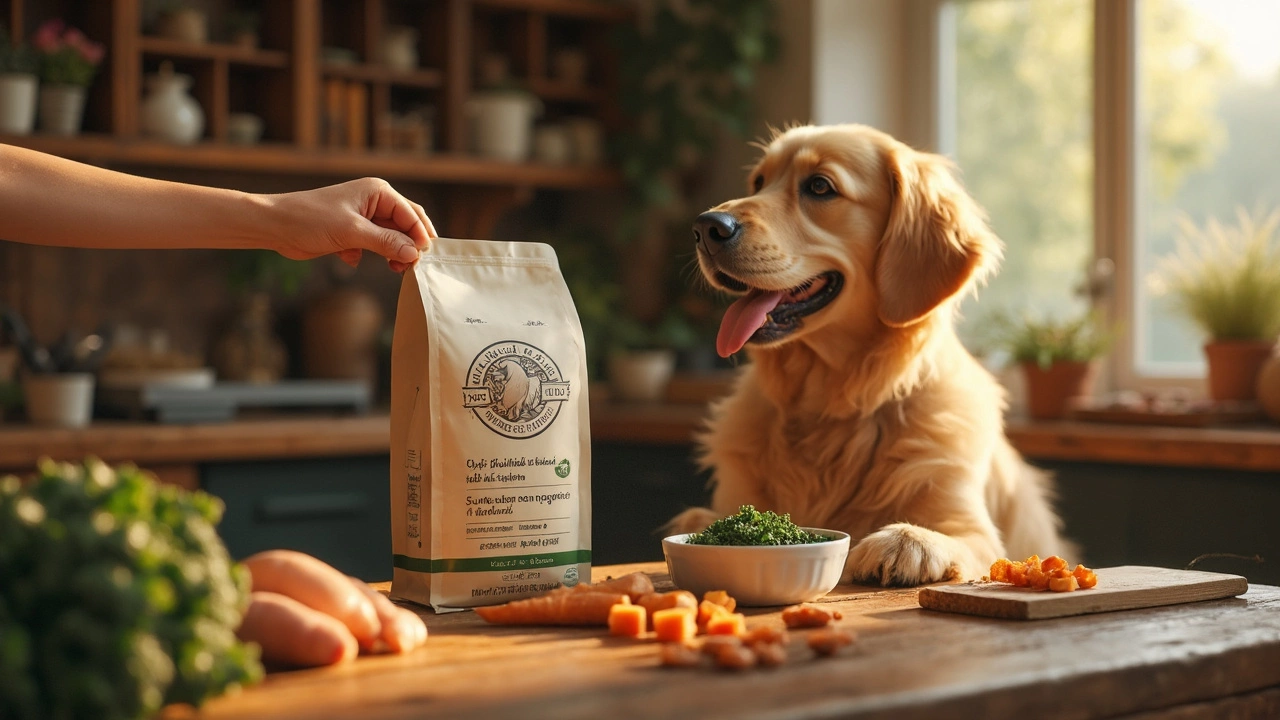Ever stare at a wall of dog food in the store and feel completely lost about what to feed your pup? Trust me, you're not alone. Finding the healthiest option for your furry buddy is not as easy as just grabbing the bag with the cutest puppy picture.
Nutrition is where it all starts. Dogs need a balanced mix of proteins, fats, vitamins, and minerals to keep their tails wagging. But here's the deal: quality counts. You want to look for foods with real meat at the top of the ingredient list.
Labels can be tricky, though. Ever seen terms like 'meat by-products' or 'cornmeal' and wondered what they mean? The healthier foods usually avoid these kinds of fillers and focus more on wholesome ingredients. We'll dig into all these details to make shopping easier.
We'll also explore which brands have a great reputation and why homemade meals might just be the right choice. Let's unravel what makes dog food truly healthy, so your canine companion can live their best life.
- Understanding Dog Nutrition
- What to Look for in Dog Food Labels
- Ingredients to Avoid
- Top Brands for Healthy Dog Food
- Homemade vs. Commercial Dog Food
Understanding Dog Nutrition
Feeding your dog isn't just about filling their bowl. Good nutrition plays a huge role in their health, energy, and even behavior. So, what exactly does a healthy dog diet look like?
Key Nutrients Your Dog Needs
Every dog needs a mix of proteins, fats, carbohydrates, vitamins, and minerals. Proteins are the building blocks for strong muscles, while fats provide energy and keep their coat shiny. Carbs aren't as important but can offer some energy too. Vitamins and minerals support everything from bone health to immune function.
Dr. Joy Karlin, a renowned veterinary nutritionist, puts it simply:
"A balanced diet tailored to a dog's unique needs can stave off illnesses and promote longevity."
Understanding Dog Food Labels
Dog food labels can be a mystery. Always check the first few ingredients. A good rule of thumb? The closer an ingredient is to its natural state, the better. So, look for recognizable items like chicken or beef rather than vague terms like 'meat meal.'
- Real Meat - Always aim for foods with real meat as the first ingredient.
- Whole Grains or Vegetables - These can be good sources of fiber and essential nutrients.
- Healthy Fats - Check for fats like fish oil or flaxseed oil for those omega-3s.
Watch Out for Common Fillers and Additives
Avoid food with too many fillers like corn and wheat, which don't offer much nutritional value. Artificial colors and preservatives? Better off without them.
| Nutrition Component | Dog's Daily Requirement |
|---|---|
| Protein | 18-25% of total calories |
| Fat | 10-15% of total calories |
Remember, not all dogs are the same! A working dog, like a border collie, has very different needs than a lap-loving bulldog. Adjust portion sizes and nutrient focus based on the breed, activity level, and age of your dog.
What to Look for in Dog Food Labels
When you're staring at that massive wall of dog food brands, labels are your best friends for making a good choice. But how do you decode all the jargon? Let's break it down.
Naming Is Key
If the label says 'chicken dog food,' it should mainly consist of chicken. But if you see words like 'dinner,' 'formula,' or 'platter,' don't be fooled—it means less actual chicken. Look for straightforward naming to ensure that meat is a primary ingredient.
Ingredient List
Ingredients are listed in order of weight, so you want to see real, whole meats like chicken, beef, or lamb at the top. Avoid anything vague like 'meat meal' or 'animal by-products,' as these can be low-quality parts.
Quality Over Quantity
Focus on the quality of the ingredients more than the quantity. Grains aren't necessarily bad, but whole grains like brown rice or oatmeal are better than fillers like cornmeal or soy. Fiber can come from veggies, so veg is always a plus.
Nutrient Guarantee
Check if the food meets AAFCO (Association of American Feed Control Officials) standards, which means it has all the essential dog nutrition components. It's like a thumbs-up for balanced meals.
Watch for Additives
Good dog foods steer clear of artificial colors, flavors, or preservatives. Natural preservatives like vitamin E and vitamin C are better options.
It's also smart to dig into the brand’s reputation and sourcing methods. Local, organic ingredients are often a good sign of a brand that's worth its price tag. Be on the lookout for claims that appear too good to be true; they often are. A little due diligence goes a long way in keeping your pup healthy!
| Typical AAFCO Nutrients (for Dogs) | |
|---|---|
| Protein | 18% |
| Fat | 5% |

Ingredients to Avoid
Diving into the world of dog food ingredients can be like opening a can of worms, literally. Knowing what to avoid is just as important as knowing what to include. Let's make sure our fluffy friends are munching on the good stuff rather than fillers and junk.
Meat By-Products
Ever seen the term 'meat by-products' on a bag of dog food? It doesn't sound very appetizing, does it? That's because it often refers to parts of animals that aren't typically eaten by humans. Sure, it's protein, but it's not the high-quality kind your pup deserves.
Corn Syrup
Corn syrup is essentially sugar used to sweeten dog food. Although dogs might love the taste, too much sugar can lead to obesity and dental issues, not to mention it's not the healthiest way to add calories to their diet.
"When selecting dog food, minimizing the inclusion of artificial preservatives and fillers can lead to a healthier and longer life for your pet," advises Dr. Jane Miller, a leading veterinarian in pet nutrition.
Artificial Preservatives
Preservatives like BHA, BHT, and ethoxyquin can be harmful over time and have been linked to health issues like organ damage. Natural preservatives such as vitamin E (mixed tocopherols) are a much safer choice.
Artificial Dyes
Your dog doesn't care what color their food is, so neither should you. Dyes like Blue 2, Red 40, and Yellow 5 are purely aesthetic and could potentially trigger allergic reactions or worse.
Fillers
Fillers such as corn, wheat, and soy add bulk without real nutritional value. These can be harder for dogs to digest and could cause a variety of health concerns ranging from food allergies to gastrointestinal issues.
Knowing these common ingredients to avoid doesn't just help you choose a healthy dog food, it ensures you provide the best for your furry family member. So next time you're out buying dog food, keep an eye on that ingredient list!
Top Brands for Healthy Dog Food
When it comes to choosing a healthy dog food brand, the sheer number of options can be overwhelming. So, let's cut through the noise and talk about some top brands that consistently deliver quality and nutrition.
1. Blue Buffalo
Blue Buffalo has made a name for itself by focusing on natural ingredients. They pride themselves on their 'Life Protection' formula that includes real meat, garden veggies, and healthy grains. Their dog foods avoid chicken or poultry by-product meals, corn, wheat, and soy. It's like a home-cooked meal for your dog in kibble form.
2. Hill's Science Diet
Recommended by veterinarians, Hill's Science Diet focuses on ingredient quality and precise nutrition tailored to different life stages and sizes. These guys aren't just throwing buzzwords around – they've got the science to back it up. Their blend is often enriched with vitamins and antioxidants.
3. Taste of the Wild
If you're looking to get your dog back to their roots, Taste of the Wild could be the way to go. It's all about the ancestral diet here, with real roasted meats and balanced nutrition that echoes what wild dogs would eat. Plus, they pack in fruits and veggies for antioxidants.
4. Wellness Complete Health
This brand emphasizes balanced nutrients that support whole-body health. The folks at Wellness are big on real meats and do away with fillers. Expect food that's full of natural probiotics, vitamins, and omega fatty acids, which are great for a shiny coat and strong immune system.
5. Orijen
Famous for their high-protein recipes, Orijen caters to dogs with active lifestyles. Their food typically lists fresh, regional ingredients, making it feel like you're feeding your dog straight from the farm. It's a bit of a splurge but often worth it for picky or active pups.
To make things a bit easier, here's a quick comparison of these options:
| Brand | Main Feature | Avoids |
|---|---|---|
| Blue Buffalo | Natural Ingredients | By-products, Corn |
| Hill's Science Diet | Veterinarian Recommended | Unbalanced Nutrition |
| Taste of the Wild | Ancestral Diet | Grains |
| Wellness Complete Health | Balanced Nutrition | Fillers |
| Orijen | High Protein | Non-Regional Ingredients |
Remember, each dog is unique, and what works for one may not suit another. It's always a good idea to chat with your vet before changing up your dog's diet. With these top brands, you're off to a solid start in providing your pup with the best dog food for their needs.

Homemade vs. Commercial Dog Food
When it comes to picking between homemade and commercial dog food, the debate can be as heated as choosing between cats and dogs. Everyone seems to have an opinion, but what’s best for your pooch?
Homemade Dog Food
Making your own dog food means you can control exactly what goes into your pup’s meal. If you’re keen on avoiding those mystery ingredients and fillers, this could be a way to go. Plus, it allows for customization based on your dog's specific health needs.
Crafting homemade meals, however, isn’t just about tossing some chicken and rice in a bowl. Balance is key! A lack of proper nutrients can lead to health problems. It's wise to consult with a vet or a pet nutritionist to ensure you're covering all bases.
Here's a simple chicken and rice recipe many dog owners start with:
- 2 ½ pounds of skinless chicken thighs
- 1 cup of uncooked brown rice
- 1 cup of chopped veggies (like carrots and peas)
- 4 cups of water
Cook everything together until the chicken is done and the rice is soft. Just make sure it's cool before serving!
Commercial Dog Food
On the flip side, commercial dog foods are designed to be balanced right out of the bag. They go through scientific testing to ensure they meet your dog's nutritional needs. Plus, let’s face it; they’re pretty convenient.
The challenge lies in finding the right brand. You want to look for foods that list a genuine meat source as the primary ingredient. Avoid those heavy on







